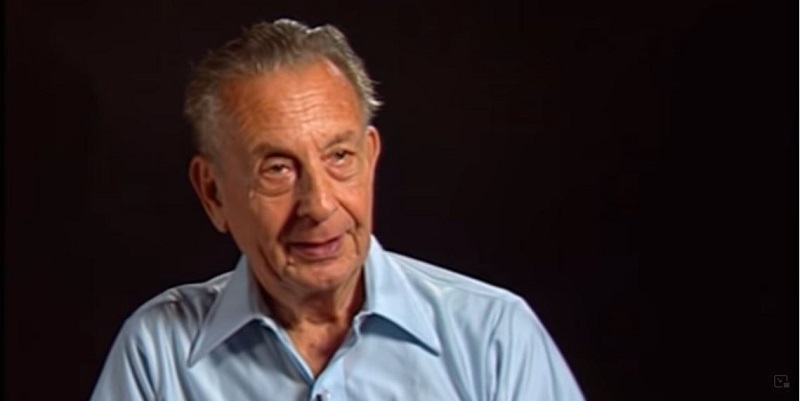George Gerbner biografie en boeken

George Gerbner (8 augustus 1919 – 24 december 2005) was een professor in de communicatie en de bedenker van de cultivatietheorie. Deze theorie stelt dat verhalen die worden verteld door een cultuur, het gedrag en de waarden van individuen bepaalt. Hij werkte onder andere voor de Temple University, de University of Pennsylvania en de Villanova University.
Biografie George Gerbner
George Gerbner’s vroege jaren
George Gerbner werd geboren in Boedapest, Hongarije, in 1919. Hij raakte al vroeg geïnteresseerd in de folklore en was een excellent dichter op jonge leeftijd. In 1938 schreef hij zich in voor de Universiteit van Boedapest nadat hij de eerste prijs had gewonnen in een competitie voor de Hongaarse literatuur.
Militaire diensttijd
Omdat hij de dienstplicht wilde ontlopen, vluchtte hij in 1939 naar Parijs. Daarna probeerde een visum te krijgen voor de Verenigde Staten omdat zijn halfbroer Laszlo Benedek daar woonde, maar deze werd geweigerd. Hij reisde daarom via Mexico naar Cuba, waar een consulent hem toestond om van Havana naar New Orleans te varen. Hier werd hij ontvangen door de vrienden van zijn halfbroer.
Studententijd George Gerbner
Aangekomen in New Orleans, liftte hij naar California. Hij schreef zich in voor de Universiteit van California, waar hij een studie psychologie en sociologie zou afronden. Gerbner was echter nog niet klaar met studeren, en in 1942 behaalde hij zijn graad in journalistiek. Hierna werkte hij kort als copy boy, reporter, copy editor, daily columnisst en financieel editor.
Waar Gerbner eerder nog officieel te boek stond vijandelijke vreemdeling, versoepelde de wet in 1942 en kon hij zich inschrijven als militair bij het Amerikaanse leger. Hij werd opgeleid als parachutist, stapte over naar het Office of Strategic Command en belandde uiteindelijk in Italië.
Na de nederlaag van Duitsland werd Gerbner naar Oostenrijk gestuurd, waar hij massakampen onderzocht van Hongaarse militairen. Gerbner hielp bij de arrestatie van Dome Sztojay, pro-nazi premier van Hongarije, en bracht hem terug naar Hongarije. Terwijl hij gestationeerd was in Hongarije, ontmoette hij actrice Ilona Kutas. In 1946 trouwde het stel.
Carrière en arbeid
Hij keerde terug naar Los Angeles en begon als vrijwilliger bij de Independent Progressive Party als krantenredacteur. Zijn activisme werd opgemerkt door het California House Un-American Committee. Kort daarna werd hij aangenomen aan het John Muir College, nu Pasadena City College, als docent journalistiek.
Om zijn bevoegdheden te halen begon hij aan een cursus aan de School of Education van de California University. In 1951 haalde hij zijn masterdiploma met zijn proefschrift ‘televisie en onderwijs’. Ook haalde hij een Ph.D. in de audiovisuele afdeling met een proefschrift ‘towards a general theory of communication’.
Cultivatietheorie van George Gerbner
Gerbner ontwikkelde voor zijn proefschrift het geweldsprofiel op televisie in die periode. Deze methode werd gemaakt als onderdeel van het Cultural Indicators Project, bestaande uit onder meer een database met meer dan drieduizend televisieprogramma’s. Deze database hielp hen bij het bieden van consistentie monitoring van geweld in uitzendingen.
Gerbner getuigde geregeld voor het congres in de Verenigde Staten en gebruikte deze geweldsprofielen om bewijs te leveren voor het feit dat de hoeveelheid geweld op televisie weinig veranderde van het ene seizoen naar het andere. Ook merkte hij op dat televisiegeweld de opvattingen van het grote publiek over geweld veranderde en het hen angstiger maakte. Hij noemde dit fenomeen het ‘mean world’ syndroom.
Dit onderzoek zou later de basis vormen voor de cultivatietheorie van George Gerbner. De belangrijkste les uit de cultivatietheorie is dat hoe meer tijd mensen besteden aan het ‘leven’ in de televisiewereld, hoe groter de kans is dat zij gaan geloven dat de sociale werkelijkheid overeenkomt met die in de televisiewereld.
Hierna trad hij in 1956 toe tot de faculteit van het Institute for Communications Research aan de Universiteit van Illinois in Urbana. In 1964 werd hij hoogleraar communicatie en tevens de decaan van de Annenberg School for Communication aan de Universiteit van Pennsylvania. Hij stopte met het werk als decaan in 1989, maar bleef lesgeven tot 1994.
Ziekte en dood George Gerbner
In 2005 werd bij George Gerbner kanker vastgesteld. Later datzelfde jaar stief hij in zijn appartement in Center City. In totaal had Gerbner 2 kinderen en vijf kleinkinderen. Na zijn dood werd tussen 2010 en 2014 een conferentie gehouden over communicatie, conflict en agressie ter ere van hem. De conferentie werd georganiseer door Dr. Jolán Róka en Dr. Rebecca M. Chory.
George Gerbner quotes
- You know, who tells the stories of a culture really governs human behavior. It used to be the parent, the school, the church, the community. Now it’s a handful of global conglomerates that have nothing to tell, but a great deal to sell.
- Fearful people are more dependent, more easily manipulated and controlled, more susceptible to deceptively simple, strong, tough measures and hard-line postures. … They may accept and even welcome repression if it promises to relieve their insecurities.
- If you can write a nation’s stories, you needn’t worry about who makes its laws. Today, television tells most of the stories to most of the people most of the time.
- The product is the delivery of the largest number of people at the least cost.
- On prime time entertainment television, scientists are most at risk. Ten percent of scientists featured in prime-time entertainment programming get killed, and five percent kill someone. No other occupational group is more likely to kill or be killed.
Boeken en publicaties
- 2018. Persian Gulf war, the movie. In Triumph of the Image (pp. 243-265). Routledge.
- 2017. Living with television: The violence profile. In The Fear of Crime (pp. 169-195). Routledge.
- 2011. Mass media discourse: Message system analysis as a component of cultural indicators. In Discourse and Communication (pp. 13-25). de Gruyter.
- 2004. Mass communication and American social thought: Key texts, 1919-1968. Rowman & Littlefield Publishers.
- 2002. Growing up with television: Cultivation processes. Media effects: Advances in theory and research, 2(1), 43-67.
- 1998. Cultivation analysis: An overview. Mass communication and society, 1(3-4), 175-194.
- 1995. Standpoint: Violence on television: The cultural indicators project.
- 1994. Growing up with television: The cultivation perspective.
- 1993. The global media debate: Its rise, fall and renewal. ABC-CLIO.
- 1987. Television: How it affects public conceptions. Issues in Science and Technology, 3(3), 109-115.
- 1986. Living with television: The dynamics of the cultivation process. Perspectives on media effects, 17-40.
- 1984. Political correlates of television viewing. Public Opinion Quarterly, 48(1B), 283-300.
- 1982. Charting the mainstream: Television’s contributions to political orientations. Journal of communication, 32(2), 100-127.
- 1982. Programming health portrayals: What viewers see, say, and do. Television and behavior: Ten years of scientific progress and implications for the eighties, 2, 291-307.
- 1981. The violent face of television and its lessons. Children and the faces of television: Teaching, violence, selling, 149-162.
- 1981. A curious journey into the scary world of Paul Hirsch. Communication Research, 8(1), 39-72.
- 1981. Scientists on the TV screen. Society, 18(4), 41-44.
- 1981. Health and medicine on television. New England Journal of Medicine, 305(15), 901-904.
- 1980. Television violence, victimization, and power. American Behavioral Scientist, 23(5), 705-716.
- 1980. The “mainstreaming” of America: violence profile number 11. Journal of communication, 30(3), 10-29.
- 1980. Aging with television: images on television drama and conceptions of social reality. Journal of communication, 30(1), 37-47.
- 1979. Women and minorities in television drama, 1969-1978.
- 1977. TV violence profile no. 8: The highlights. Journal of Communication, 27(2), 171-180.
- 1977. The many worlds of the world’s press. Journal of communication, 27(1), 52-66.
- 1972. Communication and social environment. Scientific American, 227(3), 152-162.
- 1972. Violence in television drama: Trends and symbolic functions. Television and social behavior, 1, 28-187.
- 1970. Cultural indicators: The case of violence in television drama. The Annals of the American Academy of Political and Social Science, 388(1), 69-81.
- 1969. Toward “cultural indicators”: The analysis of mass mediated public message systems. AV communication review, 17(2), 137-148.
- 1969. Analysis of communication content.
- 1966. On defining communication: still another view. Journal of Communication.
- 1965. Institutional pressures upon mass communicators. The Sociological Review, 13(1_suppl), 205-248.
- 1964. Ideological perspectives and political tendencies in news reporting. Journalism Quarterly, 41(4), 495-516.
- 1958. On content analysis and critical research in mass communication. Audiovisual communication review, 6(3), 85-108.
- 1956. Toward a general model of communication. Audiovisual communication review, 4(3), 171-199.
Citatie voor dit artikel:
Janse, B. (2021). George Gerbner. Retrieved [insert date] from Toolshero: https://www.toolshero.nl/bekende-auteurs/george-gerbner/
Oorspronkelijke publicatiedatum: 19/07/2021 | Laatste update: 16/05/2023
Wilt u linken naar dit artikel, dat kan!
<a href=”https://www.toolshero.nl/bekende-auteurs/george-gerbner/>Toolshero: George Gerbner</a>












